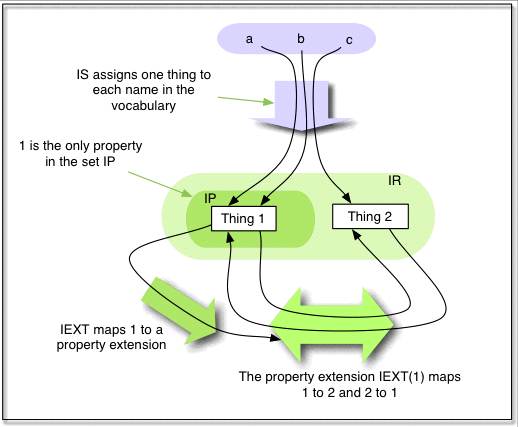-- 发布时间:9/7/2004 10:09:00 PM
--
1.4 Denotations of Ground Graphs
The denotation of a ground RDF graph in I is given recursively by the following rules, which extend the interpretation mapping I from [URL=http://www.w3.org/TR/rdf-mt/#defname#defname]name[/URL]s to ground graphs. These rules (and extensions of them given later) work by defining the denotation of any piece of RDF syntax E in terms of the denotations of the immediate syntactic constituents of E, hence allowing the denotation of any piece of RDF to be determined by a kind of syntactic recursion.
图的指派:上面定义了一个图的解释,但没有给出图的真值判断方法。指派定义方法是从基本的语法元素开始,然后利用的语法的递归,定义一个图的指派。
In this table, and throughout this document, the equality sign = indicates identity and angle brackets <x,y> are used to indicate an ordered pair of x and y. RDF graph syntax is indicated using the notational conventions of the [URL=http://www.w3.org/TR/rdf-testcases/#ntriples]N-Triples[/URL] syntax described in the RDF test cases document [[URL=http://www.w3.org/TR/rdf-mt/#ref-rdf-tests#ref-rdf-tests]RDF-TESTS[/URL]]: literal strings are encloded within double quote marks, language tags indicated by the use of the @ sign, and triples terminate with a 'code dot' . .
Semantic conditions for ground graphs.
if E is a plain literal "aaa" in V then I(E) = aaa
if E is a plain literal "aaa"@ttt in V then I(E) = <aaa, ttt>
if E is a typed literal in V then I(E) = IL(E)
if E is a URI reference in V then I(E) = IS(E)
if E is a ground triple s p o. then I(E) = true if
s, p and o are in V, I(p) is in IP and <I(s),I(o)> is in IEXT(I(p))
otherwise I(E)= false.
if E is a ground RDF graph then I(E) = false if I(E') = false for some triple E' in E, otherwise I(E) =true.
If the vocabulary of an RDF graph contains names that are not in the vocabulary of an interpretation I - that is, if I simply does not give a semantic value to some [URL=http://www.w3.org/TR/rdf-mt/#defname#defname]name[/URL] that is used in the graph - then these truth-conditions will always yield the value false for some triple in the graph, and hence for the graph itself. Turned around, this means that any assertion of a graph implicitly asserts that all the [URL=http://www.w3.org/TR/rdf-mt/#defname#defname]name[/URL]s in the graph actually refer to something in the world. The final condition implies that an empty graph (an empty set of triples) is trivially true.
除了对词汇中的名字解释,还需递归定义RDF图上每一句法E在I中的值:
1. 如果E 是一个平凡文字,那么 I(E)=E;
2. 如果E 是一个类型文字,那么I(E)= IL(E);
3. 如果E 是URI,那么I(E)=IS(E);
4. 如果E是不带空节点的三元组<s, p, o>,则 I(E)=真 当且仅当s, p 和o 属于V, I(p)属于IP, 且 <I(s), I(o)>属于IEXT(I(p));
5. 如果E是RDF图,则 I(E)=假 当且仅当 图E中存在某个三元组E’ 使得 I(E’)=假,否则 I(E)=真
上述也称为简单解释的语义条件。如果词汇中存在某个名字,I却没有给予解释,则该图赋值为假。此外,显然空图是真的。
Note that the denotation of plain literals is always in LV; and that those of the subject and object of any true triple must be in IR; so any URI reference which occurs in a graph both as a predicate and as a subject or object must denote something in the intersection of IR and IP in any interpretation which satisfies the graph.
平凡文字的指派都是属于LV的,赋值为真的三元组的主体和客体的指派都属于IR。如果对一个真值为假的三元组,就没有这个约束了。
As an illustrative example, the following is a small interpretation for the artificial vocabulary {ex:a, ex:b, ex:c, "whatever", "whatever"^^ex:b}. Integers are used to indicate the non-literal 'things' in the universe. This is not meant to imply that interpretations should be interpreted as being about arithmetic, but more to emphasize that the exact nature of the things in the universe is irrelevant. LV can be any set satisfying the semantic conditions. (In this and subsequent examples the greater-than and less-than symbols are used in several ways: following mathematical usage to indicate abstract pairs and n-tuples; following N-Triples syntax to enclose URI references, and also as arrowheads when indicating mappings.)
IR = LV union{1, 2}
IP={1}
IEXT: 1=>{<1,2>,<2,1>}
IS: ex:a=>1, ex:b=>1, ex:c=>2
IL: "whatever"^^ex:b =>2

Figure 1: An example of an interpretation. Note, this is not a picture of an RDF graph.
The figure does not show the infinite number of members of LV.
This interpretation makes these triples true:
<ex:a> <ex:b> <ex:c> .
<ex:c> <ex:a> <ex:a> .
<ex:c> <ex:b> <ex:a> .
<ex:a> <ex:b> "whatever"^^<ex:b> .
For example, I(<ex:a> <ex:b> <ex:c> .) = true if <I(ex:a),I(ex:c)> is in IEXT(I(<ex:b>)), i.e. if <1,2> is in IEXT(1), which is {<1,2>,<2,1>} and so does contain <1,2> and so I(<ex:a <ex:b> ex:c>) is true.
The truth of the fourth triple is a consequence of the rather idiosyncratic interpretation chosen here for typed literals.
这些三元组在这个(简单)解释下都是真的,但在别的(简单)解释下,就可能为假了。如果在任意解释下都为真,那它就是全真式,后面的RDF解释,RDFS解释会提到。
In this interpretation IP is a subset of IR; this will be typical of RDF semantic interpretations, but is not required.
一般来说IP是IR的子集,因为属性也可以当成资源,作为三元组的主体或客体,都这并不是必须的。因为可能在我的图中,并不是所有的属性都做为了主体或客体。
It makes these triples false:
<ex:a> <ex:c> <ex:b> .
<ex:a> <ex:b> <ex:b> .
<ex:c> <ex:a> <ex:c> .
<ex:a> <ex:b> "whatever" .
For example, I(<ex:a> <ex:c> <ex:b> .) = true if <I(ex:a), I(<ex:b>)>, i.e.<1,1>, is in IEXT(I(ex:c)); but I(ex:c)=2 which is not in IP, so IEXT is not defined on 2, so the condition fails and I(<ex:a> <ex:c> <ex:b> .) = false.
It also makes all triples containing a plain literal false, since the property extension does not have any pairs containing a plain literal.
在这个解释下,如果三元组中有简单文字,则为假,因为属性的解释函数(IEXT)中没有包含任意的简单文字。
To emphasize; this is only one possible interpretation of this vocabulary; there are (infinitely) many others. For example, if this interpretation were modified by attaching the property extension to 2 instead of 1, none of the above triples would be true.
一个图的解释有无穷多个。
This example illustrates that any interpretation which maps any URI reference which occurs in the predicate position of a triple in a graph to something not in IP will make the graph false.
如果解释没有把谓词URI映射为到IP,则包含此谓词的三元组肯定为假。